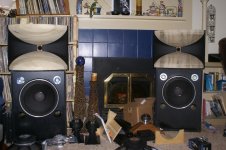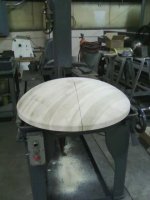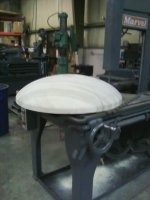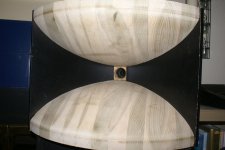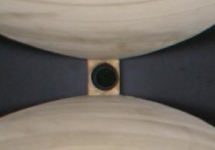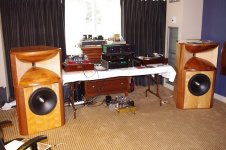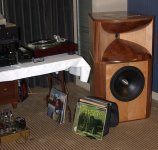Hi All. I just bought a wood lathe and want to build a pair of 1Khz Yuichi horns. On the blue print there is a center line that is ticed off at some increment but I can't figure out what the increment means.
See the pic below. The increment starts at 4 and ends at 16. I've been reading blue prints for years and have never seen where a segment is not marked for length.
That AK-1 is one cool looking horn assembly!.....I don't think a wood lathe will be of much use building those top and bottom laminated blocks though.
They will need to be cut, shaped and contoured by hand. The top and bottom blocks are going in two directions (compound).
All units of measure are in mm unless otherwise noted.....the only otherwise note is the thickness of the side blocks in cm (4cm) or 40mm.
The radius origin point is not really on the paper as it's a vanishing point and is located 34mm down from the STA mark 6 at the throat entrance.
Each STA mark is 10mm.
If you measure from the throat entrance starting at the 6 mark (zero) the 16 mark is 34mm+100mm=134mm.
This type of drawing is very common in ship building and is done in the "lofting" fashion in order to depict compound curves.
It's sometimes better to only show a half section with these though rather than the full section as shown....a matter of preference as they are mirror.
So in the one view at STA 16 the "loft" (or curvature) is 104mm from the center line and in the other direction the loft (curve) is 35. You need point points to get the compound curve correct. You need to use a "french" or "lead" curve to layout the actual curve between points they are not straight lines as someone depicted in the staircase step drawing.
This is an analog horn made of wood not a digital one!!...LOL
I've built tractrix horns with the lathe. It actually work very well and out of one disc I get 4 horn halves which is enough to build two horns.
I think that little red dip in your drawing shows the picture might not be accurate, but I'm not sure there should be a dip there either.
I think that little red dip in your drawing shows the picture might not be accurate, but I'm not sure there should be a dip there either.
The centre/origin of the arcs are at 2.6 cm on the vertical axis, 14mm below the opening.
dave
To my mind Dave, that would be the center of the disc.
I've built tractrix horns with the lathe. It actually work very well and out of one disc I get 4 horn halves which is enough to build two horns.
I think that little red dip in your drawing shows the picture might not be accurate, but I'm not sure there should be a dip there either.
OK...I think I see your use of the lathe
So what your planning would be a solid block of wood roughly 260mm in diameter and 150mm deep and then turn that on a lathe similar to gouging a bowl but working from the center base outward to the flare creating the horn shape?....correct?
Then you would cut that into quarters and then fabricate the end plates and throat adapters...2 horns!
That would be interesting and a cool way of doing it!
Would you need to bore a hole into the center of the block first?
That would be a fun video to watch!
Yes, that is how we did it before. I don't bore a hole in the center because I need that wood to hold this all up while turning. I will turn the top and bottom but in this case I will cut the curved sides on the band saw.
Here are pix of the 250hz tractrix horns will had turned by the guy who is now teaching me how to turn.
I am starting out with the 1Khz horns out of plywood just to get the process down.
Here are pix of the 250hz tractrix horns will had turned by the guy who is now teaching me how to turn.
I am starting out with the 1Khz horns out of plywood just to get the process down.
Attachments
Those horns are pretty!Here are pix of the 250hz tractrix horns will had turned by the guy who is now teaching me how to turn.
A smooth throat to horn transition really makes a difference in frequency response and reduction of diffraction effects.
The horn would sound better if you make the throat square smaller than 1", and file it out in a smooth round to square transition, like Hughes' "quadratic throat".
Having compared the difference, found it was not subtle to my ears or measurement. Takes a long time filing, but compared to all the other lathing and sanding, probably not much by comparison.
Have fun, let the chips fall where they may!
Attachments
I was just wondering if you couldn't take a full diameter block and bore out stepped blind? dead end holes and leaving enough material at the throat end to keep the block mounted to the chuck. It would of course need to be much deeper than the finished horn length.
Then have space to turn the guts to the final smooth curve.
Then band saw or cut off the chuck throat end leaving you a smooth 2" throat.
But then when I think about it wouldn't it also make some sense to just cut the top and bottom on the band saw like the ends?
Well maybe that would work...but then you wouldn't get to use your lathe !...
Anyway looks like a cool and ambitious project djn....for sure!
I hope you post photos or videos and such in this thread so I can follow!
Then have space to turn the guts to the final smooth curve.
Then band saw or cut off the chuck throat end leaving you a smooth 2" throat.
But then when I think about it wouldn't it also make some sense to just cut the top and bottom on the band saw like the ends?
Well maybe that would work...but then you wouldn't get to use your lathe !...
Anyway looks like a cool and ambitious project djn....for sure!
I hope you post photos or videos and such in this thread so I can follow!
Those where just HD lumber and the black sides was from a cheap scraped laminated book case. They were just for experimenting with the process. Here are pix of the finshed speakers. The horns are made from mahogany.
Attachments
I am a little held up right now because I need to finish my audio rack, then rearrange the shop for the new lathe.
Here is the new rack. I just need to put one last coat of varnish on the boards and paint all the steel bits.
http://www.diyaudio.com/forums/everything-else/226381-finishing-my-audio-rack-many-pix.html
.
Here is the new rack. I just need to put one last coat of varnish on the boards and paint all the steel bits.
http://www.diyaudio.com/forums/everything-else/226381-finishing-my-audio-rack-many-pix.html
.
Those where just HD lumber and the black sides was from a cheap scraped laminated book case. They were just for experimenting with the process. Here are pix of the finshed speakers. The horns are made from mahogany.
Those are even prettier!
Beautiful!
I think that little red dip in your drawing shows the picture might not be accurate, but I'm not sure there should be a dip there either.
There should not be a dip there.
dave
Oh yeah, never spun the headstock around, guessing it could go as big as 80" (maybe with a few sandbags!) Did you need a separate tool stand, or did your pivot enough to do all that you needed?
Looking at perhaps upgrading and purchasing a Union Graduate Bowl turning lathe just for this purpose, till the my Axminster one will do.
Looking at perhaps upgrading and purchasing a Union Graduate Bowl turning lathe just for this purpose, till the my Axminster one will do.
- Status
- This old topic is closed. If you want to reopen this topic, contact a moderator using the "Report Post" button.
- Home
- Loudspeakers
- Multi-Way
- Need help reading blue prints for wood horns.
